In the final update of his long-term review, Rob reflects on the year he's spent with the Firebird, the changes he's made to the build along the way and whether he'd spend his own money on Pivot's longest-travel enduro bike.
It’s always a strange feeling when your time on a bike comes to an end, especially if you’ve grown to love it.
My final ride on the Firebird was a night shoot for a video on MBUK TV. Being able to ride at speed in the dark requires great lights as well as total trust in your bike.
After 12 months aboard the Firebird, that trust was definitely there and I felt I could attack the more technical trails with total faith in the tyres and suspension, never needing to second guess how it’d behave.
But I certainly took some time to get to this point.
I’ve always got on well with Pivot bikes, having loved my year aboard the older Phoenix downhill bike, so my expectations were high. However, my initial build made bonding with the bike harder than I expected.
While I ordered a number of parts to get the Firebird built up, I stuck an older Fox 38 fork on the front. I’d previously had the fork set up with 180mm of travel – the maximum the Firebird will accept – and figured it should be fine.

After a few runs down a trail I know inside out, I was struggling to get into the swing of things. As it turns out, with this fork in place, the Firebird’s bottom bracket sits at a lofty 355mm off the floor.
Getting the travel of the 38 dropped to 170mm and the new GRIP X2 damper fitted quickly sorted this (although I think the bottom bracket could go even lower) and I began to get a proper feel for the bike, lapping some seriously rough and fast trails in South Wales.
With 29in wheels at the front and rear, and 165mm of travel on tap, the Firebird can cover chunky terrain seriously fast, as I quickly found out.
The solidly built carbon frame feels accurate and responsive, taking rider inputs and translating them into rapid changes of direction as and when you need to switch lines or dodge obstacles.
Banked over in a battered turn, there’s more feedback coming through the bike compared to some, though.
That’s not to say the Firebird is at all uncomfortable; it’s more that it’s clearly a razor-sharp race machine, built for precision.
Plus, a lot of that feedback is muted thanks to the impressively supple suspension, which sinks into its travel with the slightest touch.
Switching over to RockShox suspension partway through the year was also really interesting.
It took a little time to find the sweet spot of the new ZEB fork, but since I did, I haven't wanted to change it.
At the rear, the new Super Deluxe shock has been a proper fit-and-forget unit. It’s possibly not quite as supple as the X2 shock it replaced, but it has still worked impressively well over the last few months.
Building the bike from the frame up enabled me to use a few parts that I hadn't ridden in some time, including the Shimano XT gearing and Hope Tech 4 V4 brakes.
Having heard mixed reports about the durability of the latest Shimano derailleurs, I can report that after a year of abuse, I’m still on the original, even if it looks a little battle-weary. Gears are still changing without issue, too, even after some serious bumps and bangs.
As for the Hope brakes, I’ve been bowled over by their light lever feel and masses of power. They might not have the same punch as SRAM’s Mavens, but they’re not a million miles off.

One slightly irritating thing about the Firebird is the Super Boost rear-axle spacing.
While I’m sure it has a measured effect on stiffness, I’m not sure I could feel the benefits on the trail. It also meant I had to order a fresh set of wheels rather than use old favourites of mine, which felt a bit of a shame.
Still, the Hunt Enduro wheels I’ve been using are still rolling straight and true, without a ding in sight, despite some very questionable line choices.
Overall, I loved my time on the Firebird, once I’d got the build sorted – an issue you’re unlikely to have if you’re buying a complete bike.
It’s a proper speed machine with impressive suspension and decent geometry, although I think there is some room for improvement here.
Would I spend £4,200 on just the frame? I’m not sure I would, because it’s a serious chunk of cash. If Pivot releases an alloy version with a standard Boost rear end, maybe I’ll change my mind, though.
Pivot Firebird in brief
The Firebird is Pivot’s longest-travel enduro bike, boasting 165mm of rear-wheel squish, along with stretched-out geometry designed to boost high-speed stability when tackling the wildest trails out there.
For my latest long-term test review, I’ve gone for a frame-only option, rather than the standard build. Why? Well, I was keen to spend some time on a variety of products this year, and this felt like the best way to go about it.
As it stands, my custom build isn’t a million miles away from Pivot's offering, but there are a number of choice tweaks that make it a little different from the norm.
It’s taken a little while to gather all the parts for the build, meaning I’ve only had a handful of days aboard the bike so far. However, the days I have had on it have been interesting and fun in equal measure.
While the masses of travel is nothing exactly new for me, having a bigger 29in rear wheel in place, after a year on a mixed-wheel bike, has taken some adjusting to.
But, my lord, this thing is fast. Give it a whiff of speed and it’ll grab onto it with both wheels and do everything it can to hold onto it. There’s room for improvement, though, largely down to one of my spec choices.
It’s a work in progress, but the potential on offer has got me desperate to get back onto the bike as soon as humanly possible.
Previous updates follow…
Pivot Firebird – update three
In a bid to make the most of some rare dry and dusty trails as summer came to an end, I took a trip to BikePark Wales and gave the Firebird a thorough thrashing. I’m pretty happy with the suspension setup now, with things feeling nicely balanced and predictable.
That meant the bike felt great while riding in ‘mates trains’ down through the A470 jump line, where the Firebird’s big 29in wheels and fast-rolling Continental tyres made clearing the jumps a breeze.
In fact, I ended up going a little deep on one landing and was quickly reminded that when the back end of the bike bottoms out, the tyre can – if it’s a really hefty hit – buzz the battery on the RockShox Reverb AXS dropper post, which is a little worrying.

Having tried but failed to reverse the post (so the battery sits at the front and out of harm's way), there’s not a whole lot I can do.
I contacted a brand that makes an offset clamp for this exact post in a bid to try to solve the problem, but it too, was unable to help.
At present, I haven't managed to bottom the bike out hard enough to rip the battery from the post, so fingers crossed, it’ll never happen.
Back to testing duties after some time off in the summer, and I’ve just fitted some new Michelin Wild Enduro Racing Line tyres. I’ve opted for the MS (mixed soft) up-front and the MH (mixed hard) at the rear.
While doing this, I noticed the Firebird’s down-tube protector has started to peel off on the non-driveside. Where this is happening, it’s collecting small-grade grit and gravel, which is far from ideal, especially considering the price of the frame.
I’ve spoken with Pivot’s UK distributor, Saddleback, and have been told swapping these over is a breeze. They’re sending me one so I can get it changed and get the Firebird looking nice and fresh again.

Other new parts include Ergon GDH grips and a Crankbrothers TS2 Tube Stash+.
The grips use a soft rubber and some subtle shaping, which helps keep your hands comfortable on long, rough descents. Thanks to some well-positioned textured sections, there’s plenty of purchase, too.
While the Tube Stash+ is handy, it’s not the best when it comes to holding thin, lightweight tubes, because they don’t pack out the strap enough. While I’d be keen to bulk the strap out with extra kit, the clearance to my bottle cage is minimal, so that isn’t really an option.

Still, the tube is in there and hopefully not going anywhere. Plus, I like the long tyre lever, which has a nifty little tyre plug kit integrated into it.
After cramming in a number of great rides on local and not so local trails while the weather was still playing ball, to cap off a great summer of riding, I headed back to BikePark Wales, this time for their ‘Weekender’ event.
Between hosting a chat and an interview, and helping to judge the whip-off competition alongside the voice of mountain biking, Rob Warner, I managed to squeeze a few laps in.

On the hard park trails that make up most of the BikePark Wales network, it didn’t take long to find the grip limits of the front tyre. That’s no major surprise, seeing as it’s designed for mixed, soft terrain. But still, pushing into some fast, rocky turns that were slick from the rain leading up to the event, having the front end catch then momentarily slip certainly got my old heart going.
Thankfully, the traction didn’t disappear completely – and I’ve done enough push-ups in my time to be able to hold on.
With the rain now coming down in torrents, this’ll likely be less of a worry, though, because I’ve no doubt nearly all the trails from now on will be a little softer and easier for the Michelins to dig into.
Previous updates follow…
Pivot Firebird – update two
As is always the way when your job involves testing bikes and products, nothing on our long-term bikes tends to stay the same for too long.
On the one hand, swapping parts makes getting a proper gauge on a product’s durability tricky. On the other, it means we’re able to get a feel for how components are progressing (or not, in some cases) and a handle on any differences in performance very quickly.
Sometimes, these differences are subtle, sometimes – especially in this case – they’re not.

With a series of updates to the RockShox range, I’d bolted a new fork and shock to the Firebird.
The new RockShox ZEB fork features a Charger 3.1 damper, as well as hosting a plethora of other tweaks in a bid to boost on-trail performance further.
Having ridden, fettled and tested all iterations of the ZEB to date – even getting one custom-tuned for my preferences – I was keen to see how these tweaks related to performance on the trail.
Now, there are times when brands will hammer us with all the marketing spiel going, promising otherworldly, race-winning performance and the game being totally and utterly changed (I may be exaggerating slightly here, but you get the idea).
In some instances, while the improvements might be obvious instantly, the game remains more or less the same.

That isn’t the case with the new ZEB. This fork offers a very different feel compared to its predecessor. That could be perceived as a bad thing because the previous-generation ZEB was a great fork. But, thanks to the changes, this new 2025 fork is even better.
The first lap at my local wood aboard the Firebird, having made these changes, did more than raise an eyebrow.
Thanks to how ridiculously supple and smooth the new ZEB is, I had to totally re-think my setup. I’d started with my stock spring pressure and damper settings (both high- and low-speed compression and rebound damping dials wound to fully open), but they just didn’t cut it here.

A little like the Lyrik of old (pre-2020), this updated fork seems to sink more easily into its travel and, if ridden hard, requires more damping to ensure it remains supportive and maintains the dynamic geometry of the bike. All of this had a knock-on effect on air-spring pressure and, due to the dramatic changes to ride feel, even had me questioning my bar height. It really was like starting from scratch.
While the new ZEB likes to hunker down a little more, it works ferociously fast in its mid-stroke, hoovering up chatter, and swallowing chunkier bumps and impacts with incredible poise.
This means there’s loads of traction and comfort on offer – two of the most important things for any mountain biker – and I’m keen to make the most of this boost in performance.
While I’m pretty happy with where I’ve got to setup-wise with the new ZEB, I think there’s still a little way to go to ensure I’m getting the best out of it.

At the rear, I’ve matched the ZEB with the updated Super Deluxe Ultimate shock, which uses a new, high-flow piston and lighter rebound check plate to smooth the transition between compression and rebound phases – along with tweaks to both compression circuits.
I’m a few rides in now, on wildly varying terrain, and feel as though I’ve managed to get a decently balanced feel to the Firebird again, which is a plus for confidence levels.
The changes RockShox has made (especially to the fork) are seriously impressive and make a genuine difference on the hill. So, while my cynical bike journalist outlook isn’t likely to change any time soon, sometimes it’s good to be reminded that you can, once in a while, believe the hype.
Pivot Firebird – update one
Finally, after what feels like months of going on about getting the fork travel in my Fox 38 reduced, I’ve done it. And when I say I’ve done it, it was actually the guys at the Silverfish Service Centre in Risca, South Wales, that did it for me.
Not only did they drop the fork travel down to 170mm, they even fitted the new GRIP X2 damper for me.
This damper is aimed at enduro and downhill riding, and has been designed from the ground up, offering more control and a better damping range than the GRIP2 it replaces.
You still get the same high- and low-compression damping and rebound damping external adjustments, but Fox says you’ll need to use the updated setting recommendations to make the most of them.
Although the spring pressure suggestions remain the same, the clicker settings for both the compression and rebound damping vary with the GRIP X2.

I stuck with the same spring pressure for my weight, but found myself adding low-speed compression damping almost instantly, simply because the fork felt smoother and sunk lower into its travel when I was pumping through trail undulations.
Whether that’s down purely to the new damper, I’m not totally sure. I’ve no doubt it helped that the guys had serviced my fork, which made it run a little more freely, but I found I needed some extra support to prevent the front end from diving.
This wasn’t an issue with the previous damper, which felt as though it was over-damped from the get-go, explaining why I ran all the dials fully open. But this certainly isn’t the case here and it’s nice to have the ability to fine-tune the fork to match the super-supple rear end of the Firebird.

That wasn’t all, though. I need to mention the travel reduction, too. Dropping 10mm in travel (from 180mm to 170mm) has dropped the bottom bracket to a more reasonable 345mm off the floor. Add some sag into the equation and the Firebird feels more balanced and stable through the turns.
Not only that, there’s a better balance to the suspension, too, which I noticed on steeper, rougher trails, where the chassis remains more stable under braking, feeling as though it’s pitching back and forth less.
With just one run, I felt I’d managed to iron out any issues and fell in love with this pricey machine. With a lot of new kit to test, though, there’s a plethora of changes on the horizon which I’m hoping won’t upset the sweet spot I’ve managed to find. Fingers crossed and #pray4robspivot.
Pivot Firebird frame, suspension and specification
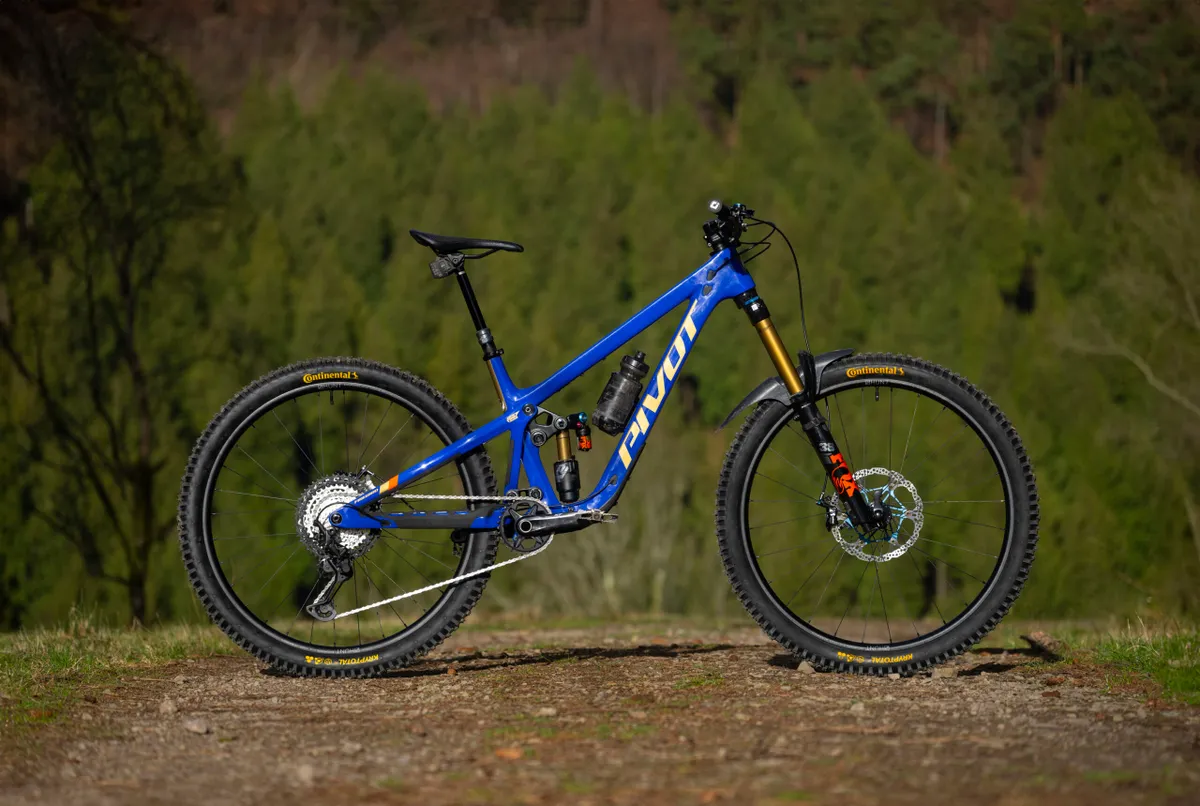
The Firebird frame is a full carbon fibre affair, which Pivot says is tuned specifically across all sizes, to help give each rider, no matter how tall or small, the same experience on the bike.
At the rear, there’s 165mm of travel, delivered via the DW-link suspension. This system uses two short links to connect the front and rear triangles and dictate the suspension kinematics.
The lower link was lengthened during the last Firebird update to better mimic the wheel path of Pivot's downhill bike, the Phoenix, in a bid to make it even more capable when charging through square-edge hits.
Pivot offers its own full builds with a coil or air-sprung shock from Fox. This is because there’s enough progression designed into the suspension system to ensure either spring type will work, providing you’ve tuned the shock to suit.
I opted to go for an air shock, simply because tinkering with spring rates is that bit simpler, plus air shocks are so good now, I wasn’t put off by using one.
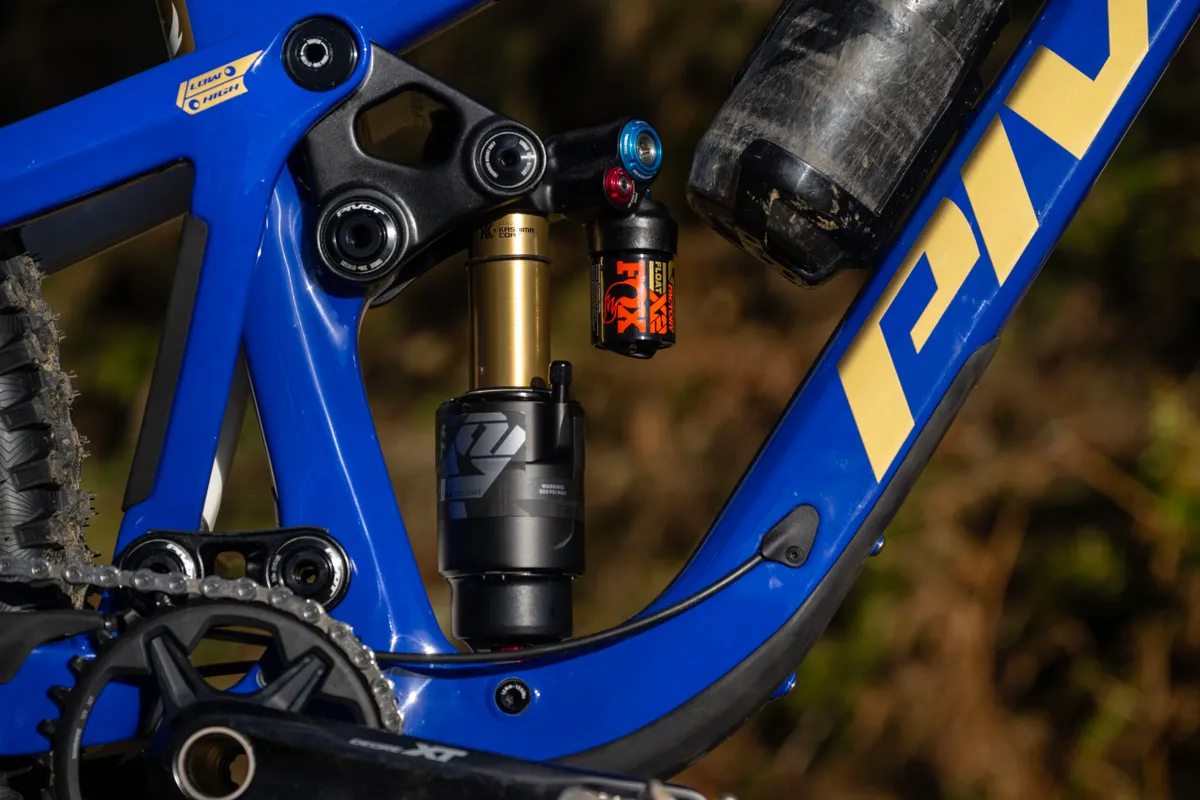
It’s worth taking note of the Super Boost Plus rear-axle standard. This is the first enduro bike I’ve had that’s used this measurement and, as a result, none of my spare wheels will fit straight into the frame.
Pivot says it has done this to add stiffness and control. I’d say it's achieved that aim, but I’m not totally convinced it needed to. More on that later.
The finish of the frame is seriously impressive, even down to the covers that clamp the cables into the internal routing.
Still, it’s a seriously expensive bit of kit.
Pivot Firebird specification
- Sizes (*tested): S, M*, L, XL
- Weight: 16.4kg (size medium, with pedals)
- Frame: carbon, 165mm travel
- Shock: Fox X2 Factory
- Fork: Fox 38 Factory, 180mm travel
- Shifters: Shimano XT
- Derailleurs: Shimano XT
- Cranks: Shimano XT
- Wheelset: Hunt Enduro Wide V2 29
- Tyres: Continental Kryptotal Fr Enduro Soft 29x24.in (fr) / Continental Kryptotal Re Downhill Soft 29x2.4in (r)
- Brakes: Hope Tech 4 V4 (220mm / 200mm rotors)
- Bar: Burgtec Ride Wide Alloy Enduro, cut to 750mm)
- Stem: Burgtec Enduro Mk3, 42.5mm
- Seatpost: RockShox Reverb AXS, 160mm
- Saddle: Ergon SM Comp
Pivot Firebird geometry
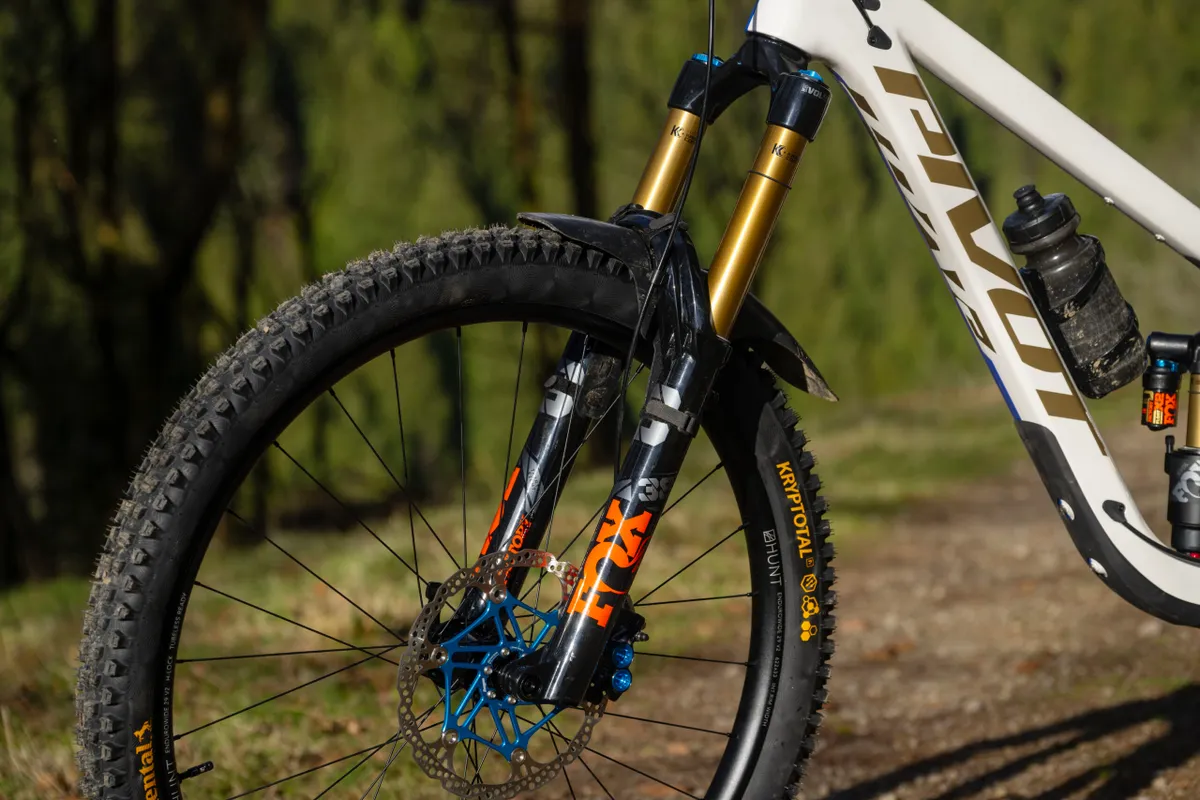
Because the Firebird is built to be ridden as fast as possible, its dimensions are designed to suit.
Before we get stuck into the numbers, because I’ve plugged a 180mm fork into the Firebird frame (the longest travel advised by Pivot), my geometry isn’t exactly identical to that of Pivot's chart.
Why have I gone for so much travel up front? In short, I just didn’t have time to reduce the travel to 170mm, but it’s something I plan to do very soon.
That’s largely down to how much it lofts the bottom bracket height up. Pivot’s geo chart says the bottom bracket sits 350mm off the floor in the low setting as standard. With the 180mm-travel fork in place, it’s now up to 355mm, which is just a little too tall for my liking.
Other key dimensions I’ve measured include the 63.8-degree head angle, the 465mm reach and the 815mm front centre, which is reasonably stretched for a medium-sized frame.
The seat tube angle is relatively steep at 76.3 degrees.
Pivot changes the effective chainstay length across the size range. The medium I have here sports 434mm chainstays, which is pretty much the standard across many bikes of this ilk and size.
One final number to mention is the effective top tube length. At 624mm, it’s quite long for a size medium.
Why did I choose this bike?

I’d love to say something clever or smart here, and while it’s true I wanted to try the Firebird because the numbers intrigued me, it really boiled down to me being such a big race fan.
After seeing the likes of Bernard Kerr, Morgane Charre and Eddie Masters ripping the life out of the Firebird on some of the coolest trails in the world, my desire to ride one become more than just an itch I needed to scratch.
I’d spent a decent amount of time on the Phoenix DH bike (back when it was on 27.5in wheels) and really got on well with it. Despite the masses of travel, it retained an efficient, eager feel that I was hoping would carry over to the Firebird.
Pivot Firebird initial setup
Once built up, I realised the Fox X2 Factory shock at the rear was cavitated and in need of a service. Thankfully Saddleback, the UK distributor for Pivot, sorted this in a couple of days, which was fantastic.
Aside from that, I’ve gone with 30 per cent sag at the rear, all damping adjustments wound off and no spacers inside the shock to suit my 68kg weight.
At the front, I’m running 77psi with no spacers inside and all the damping adjustment wound off.
The only other personal tweak is to cut my bar down to 750mm and tip the saddle nose downwards, largely to create a comfier position with a straighter back while I’m climbing.
Pivot Firebird ride impressions
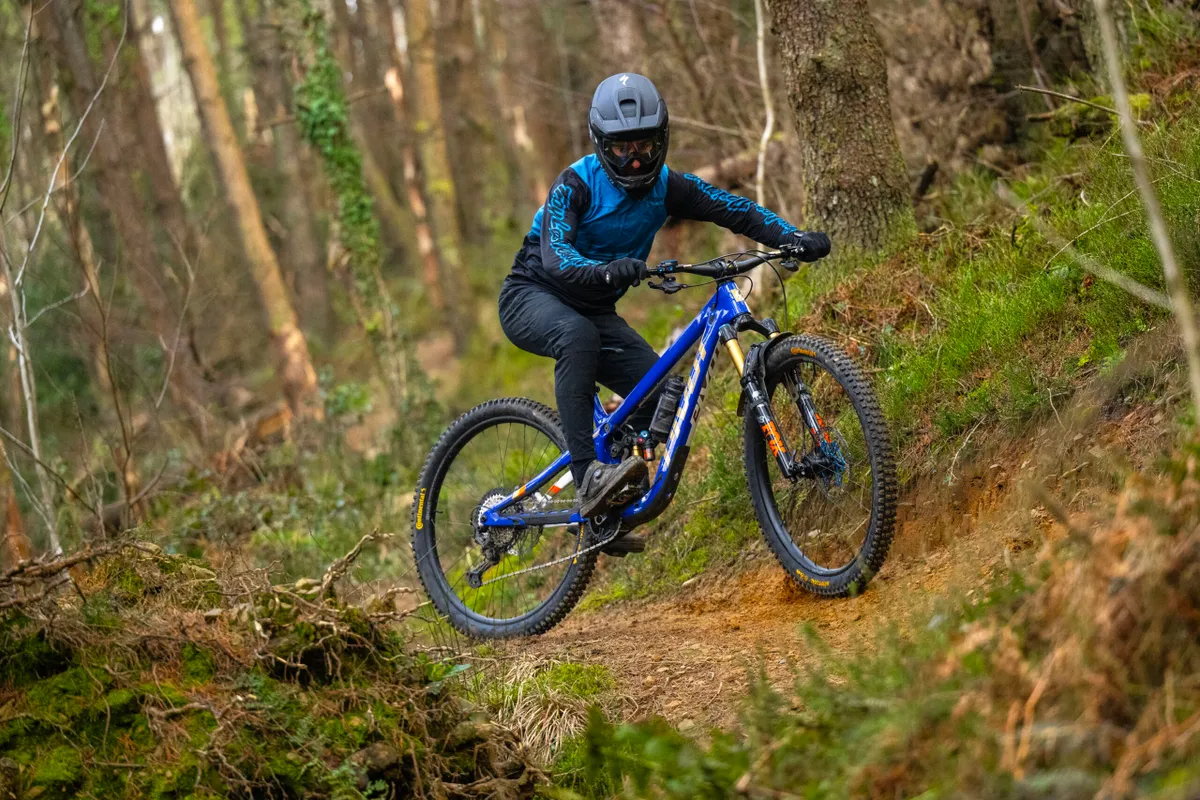
Straight from the off, the Firebird feels lighter than the 16.4kg weight might suggest when climbing.
I put this down to a couple of things. First off, get the cranks spinning and the rear suspension seems to stay incredibly calm. We’re not talking quite as calm as Captain America in a crisis, but when pointed uphill and with your backside planted on the saddle, the Firebird feels incredibly efficient.
Secondly, the frame is stiff. The short, stout links, carbon tubes and that broad Super Boost Plus axle spacing seemingly add up to a bike that feels taut and urgent when you’re putting the power down.
The relatively long effective top tube measurement also makes it feel more stretched out than most of the enduro bikes I spend a lot of my time on. Compared to a good chunk of those, the Firebird is around 25-30mm longer in this particular area, making me reach that bit further to the bars.
That’s okay, too, because it feels good on steeper climbs. I was initially tempted to shift my stem up 5mm on the fork steerer tube to raise my bar a little more and make things feel a little more upright, but because I like how the front of the bike feels and my bar height when I’m up out of the saddle, I’ve left it as is for now.
Finally, although I ran Continental tyres on my bike last year, I’ve gone for the same tread and rubber compound front and rear, but moved to a downhill-casing tyre at the rear, for a bit more peace of mind.
What's most impressed me about the Conti tyres is that despite the dependable grip and how well they wear, they seem to roll at a decent pace too. So, although I’ve got a heavier rear tyre out back now, the Firebird feels sprightlier uphill than many of its counterparts that are lighter and come with less robust rubber.
Carving corners
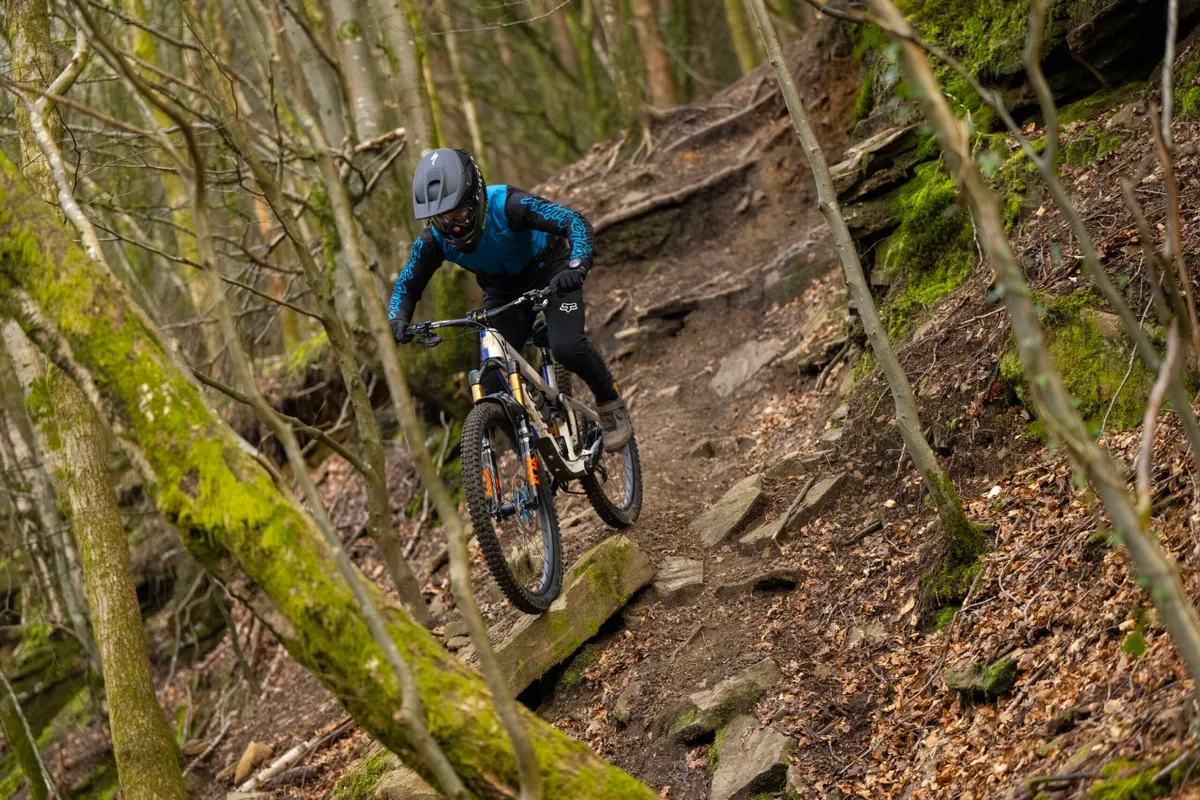
The Firebird’s climbing prowess is a bonus. It’s nice it’s so well-mannered on the climbs, but I’d be okay if it wasn’t, just as long as it was a rocket ship on the way back down.
Thankfully, it doesn’t disappoint in this department either.
Getting it up to speed feels easy. The pick-up from the Hunt wheels is snappy enough to keep things feeling reactive when you get on the gas, and as soon as the Firebird gets a whiff of pace, it’ll keep it for as long as it possibly can.
I think I’m in a good place with the suspension balance, having now experimented with fork volume spacers, before settling on using none.
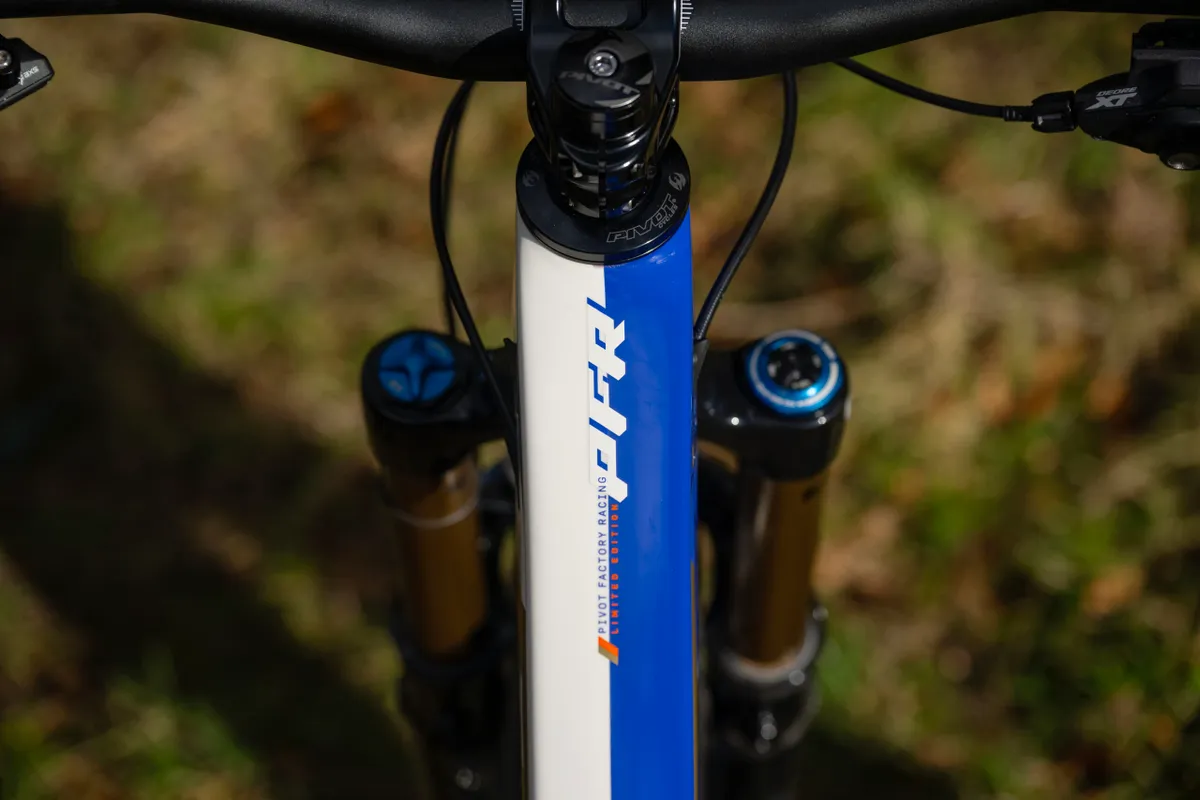
This means I can confidently stand in what feels like the centre of the bike and let it do its thing as I keep it on track.
The rear suspension is nice and supple, tracking the terrain effortlessly. Smashing through sections at pace feels like a confident affair.
Bank it over into a cut-up, bump-riddled turn, though, and it's not quite there.
While the frame’s stiffness means there’s a bit more in the way of feedback once the bike is pitched over, it’s the height of the bottom bracket that got me feeling a little unsettled at first.
With that 180mm fork in place, it’s just too high right now, and I need to get the fork travel reduced to help this. I’m not saying I want to be clipping my pedals on the ground constantly, but getting the Firebird’s belly a little closer to terra firma would only help the handling, in my opinion.
It’s a work in progress for sure. But there’s no denying the potential that’s already shining through.
Parts mean prizes
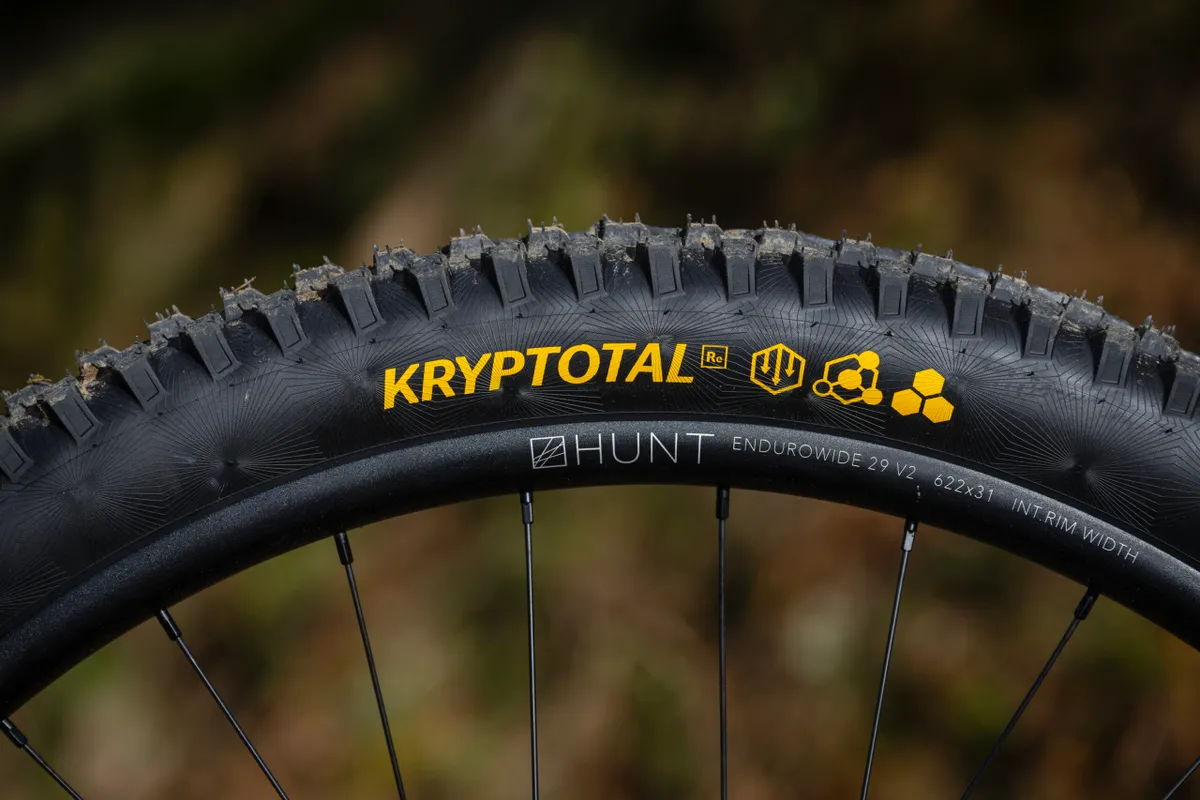
Along with the tyres, I’m pleased with the rest of the spec, too. Well done, me!
The Burgtec bar and stem are nicely finished, well-shaped and feel solid.
Similarly, the RockShox Reverb AXS post, although well-used (and pulled from a previous bike) is still probably my favourite dropper post of all time. I’d love the stack height to be a little shorter, and ideally, I’d run the 170mm dropper post if I had one, but there’s no getting away from how slick this thing is.
Something else that needs mentioning is the brakes. As I’ve said, the Pivot is keen to keep its speed and good at doing so. As a result, having good anchors to slow it down when needed is important.
The Hope Tech 4 V4s are formidable stoppers. The power is immense but easy to control – something I’ve really come to appreciate on one of my regular test tracks, which is steep and rough.
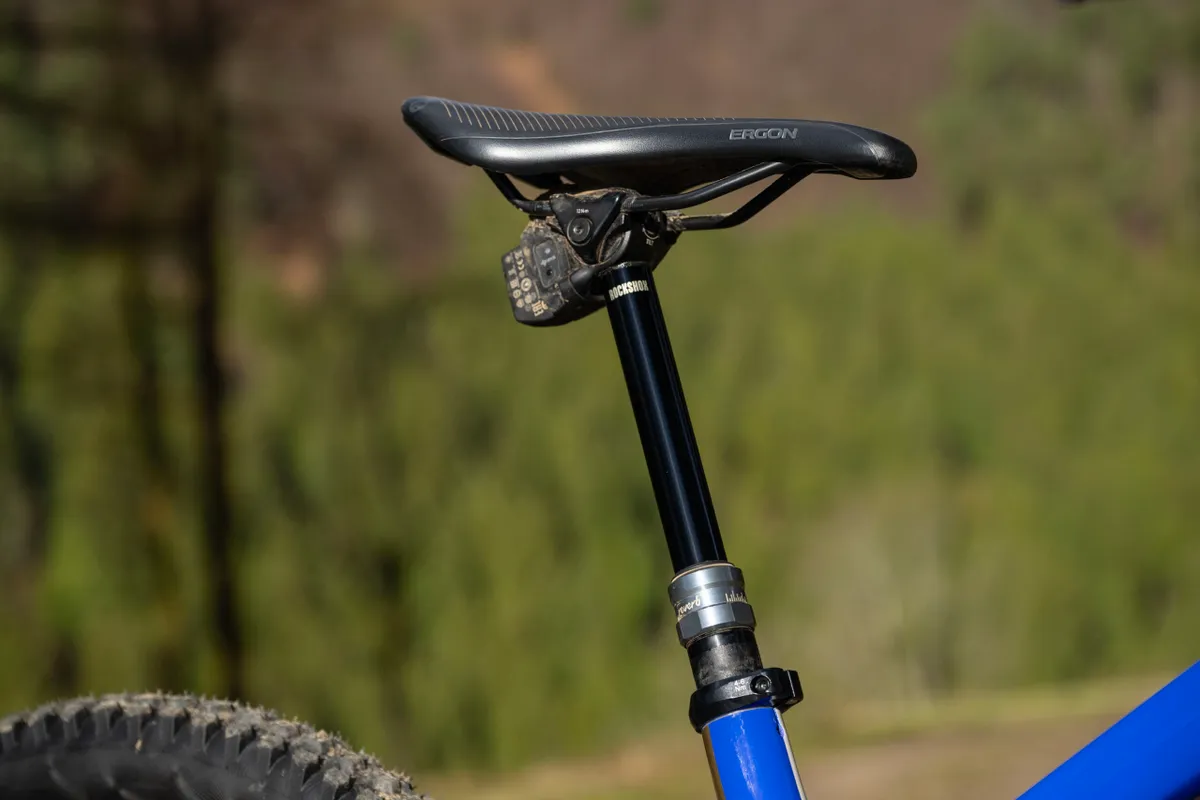
While I don’t regret including the Shimano XT drivetrain, I’ll admit, it’s certainly not as smooth as the current SRAM equivalent once it’s caked in mud.
Yes, on the whole, this build is working really rather well so far. But there is work to be done.
Pivot Firebird upgrades
As I’ve mentioned already, the 180mm-travel fork is throwing things out a little too much for my liking, so the first port of call is to get the travel reduced.
Other than that, I’m not keen on changing anything else on the Firebird for some time.
BikeRadar‘s long-term test bikes
BikeRadar's long-term test bikes give our team the opportunity to truly get to grips with these machines, so we can tell you how they perform through different seasons and on ever-changing terrain, through a year of riding.
Some choose a bike from their favoured discipline and ride it hard for a year, others opt for a bike that takes them outside of their comfort zone.
We also use our long-term bikes as test beds for the latest kit, chopping and changing parts to see what really makes the difference – and help you decide which upgrades are worth spending your money on.
These bikes also provide an insight into the team's riding through the year – how they like to ride and where life on two wheels takes them, from group rides on local lanes and trails, to adventures further afield.
To see all of the BikeRadar team’s long-term test bikes – and to stay up-to-date with the latest updates – visit our long-term review hub.
Product
| Brand | Pivot |
| Price | £4200.00 |
| Weight | 16.40kg |
Features
| Fork | Fox 38 Factory |
| Tyres | Continental Kryptotal Fr Enduro Soft 29x24.in (fr) / Continental Kryptotal Re Downhill Soft 29x2.4in |
| Brakes | Hope Tech 4 V4 (220mm / 200mm rotors) |
| Cranks | Shimano XT |
| Saddle | Ergon SM Comp |
| Wheels | Hunt Enduro Wide V2 29 |
| Seatpost | RockShox Reverb AXS, 160mm |
| Handlebar | Burgtec Ride Wide Alloy Enduro, cut to 750mm |
| Rear shock | Fox X2 Factory |
| Available sizes | S, M*, L, XL |
| Rear derailleur | Shimano XT |
| Front derailleur | Shimano XT |
